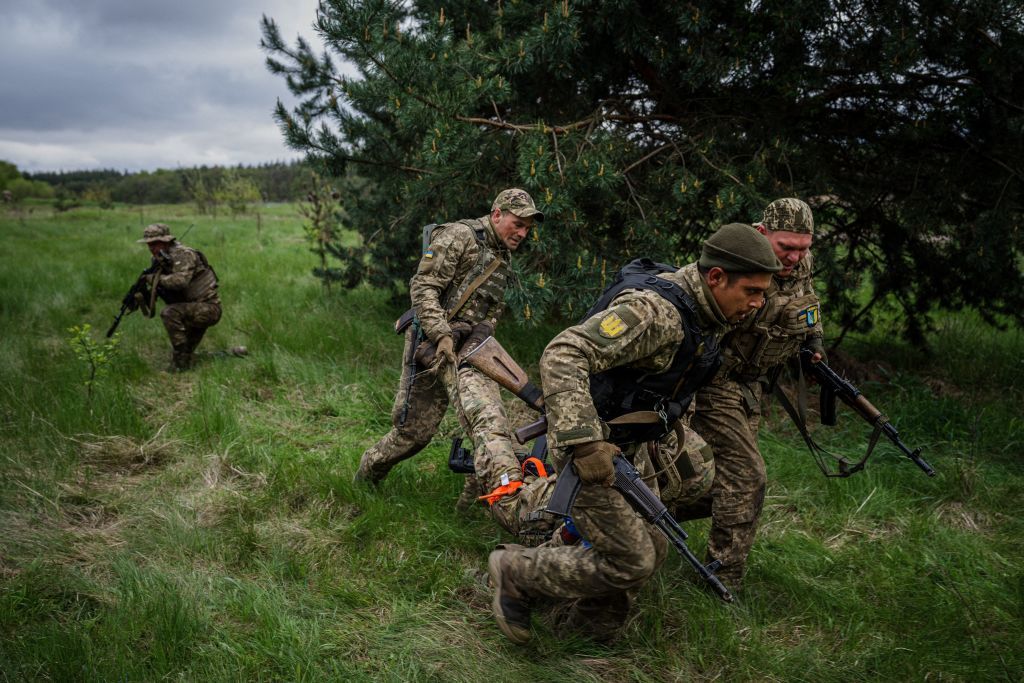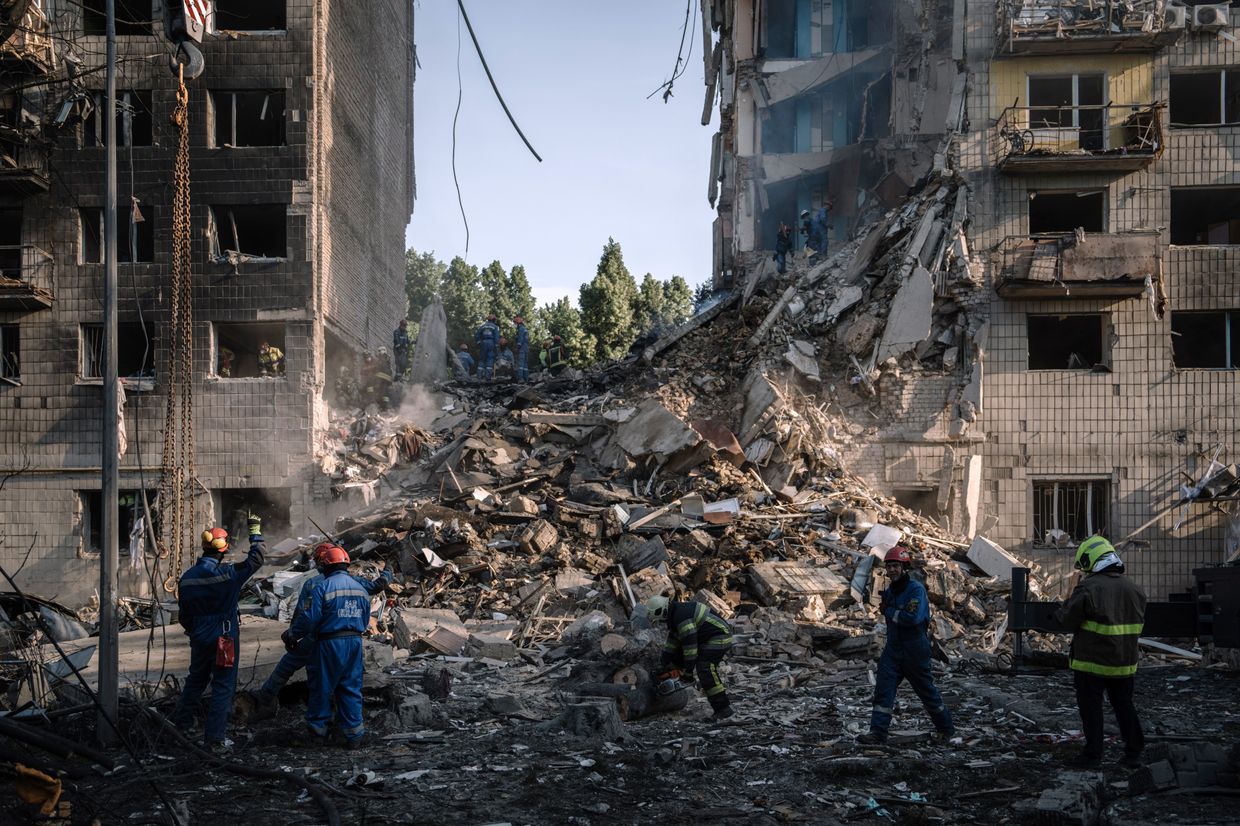Russia is increasingly deploying unidentified gas in its latest chemical warfare tactic against Ukrainian troops, who are losing ground across the hotspots of the eastern front line.
Ukraine is currently unable to identify the majority of the gas used on the battlefield, compared to previous months when it could diagnose about half of the chemicals, according to Ukrainian Colonel Artem Vlasiuk.
Russian troops have used chemical agents banned in warfare as a psychological operation to sow panic among the Ukrainian forces, said Vlasiuk from the Support Forces’ Radiation, Chemical and Biological Protection Command, a branch of the army responsible for inspecting chemical warfare.
Russian drones throw gas grenades into dugouts or trenches in a brutal tactic to force Ukrainian soldiers out into the open field, making them easy prey for drone or artillery attacks.

Of the 323 recorded cases of Russia's chemical attacks in October, nearly all except 15 incidents were "unidentified," Vlasiuk told the Kyiv Independent on Oct. 28.
The officer said that Ukraine struggled to identify the new types of gas because it lacked sophisticated high-end detector technology to diagnose beyond the few prototypes in its library.
“It is dangerous both for our troops and for Ukraine as a whole, which will not be able to prove anything at the international level,” Vlasiuk said.

More detectors needed from Kyiv’s Western allies
Ukraine needs “hundreds” of complex detectors that cost $100,000 to $600,000 each to better identify what exactly is being used by Russian troops, according to the colonel. Kyiv also needs additional simpler ones already being used to identify whether there are “dangerous chemicals,” he said.
The insufficient number of detectors to identify gas makes it harder for Ukraine to record what Russian troops are deploying, in what quantity and in which parts of the front line, Vlasiuk added.
The colonel said gaining Western interest in providing these sophisticated detectors to Ukraine has proven difficult. Other resources seen as more crucial, such as ammunition, are usually considered the priority.
Discussions are held at venues such as the Ramstein format meetings, also known as the Ukraine Defense Contact Group, which are held nearly monthly, he added. The upcoming one, delayed last month, is scheduled for November in a virtual conference call format.
Identifying chemical agents is “very easy” with the right detectors, according to Hamish de Bretton-Gordon, former commanding officer of the U.K.’s Joint Chemical, Biological, Radiological and Nuclear Regiment. He estimated that Ukraine might need “a few hundred” hand-held detectors that cost roughly $10,000 to $50,000 each.

Detectors can help confirm war crimes and help treat troops
Ukraine has recorded over 4,600 cases of Russian gas attacks on the battlefield since the beginning of the full-scale invasion in 2022, according to Support Forces. Vlasiuk said the types of gas identified thus far are CS and CS tear gas, as well as ammonia and chloropicrin. Many more could have gone unrecorded, he added.
The use of chemical agents, including tear gas – even if not lethal – on the battlefield is a violation of the 1993 Chemical Weapons Convention, a post-Cold-War disarmament treaty that bans the use of chemical weapons in war and obliges countries to eliminate them. The Organisation for the Prohibition of Chemical Weapons (OPCW), a United Nations watchdog, says that tear gas is “considered chemical weapons if used as a method of warfare.”
“We can detect CS, but if the enemy uses something else more complex, newer, or a mix that is similar in composition but not CS, we can't identify it,” Vlasiuk said, explaining that presenting evidence to Western allies and the OPCW is difficult.

Ukraine’s concerns for the new types of gas found on the battlefield come as Russian troops continue to thrust forward across the hotspots of the war in eastern Ukraine, increasingly capturing villages and towns. The Ukrainian defense remains stretched across the front line, with many of its soldiers exhausted after having fought for nearly three years with little break.
Gathering evidence to record such incidents is especially difficult in Russia’s Kursk Oblast, where Ukraine launched a bold cross-border incursion in August.
A handful of soldiers deployed in the area told the Kyiv Independent that they had suffered gas attacks on their position in Kursk Oblast, including one who said he had suffered multiple a day.
Colonel Vlasiuk said that he knew of one October incident in which five soldiers suffered light symptoms from a gas attack in Kursk Oblast, adding that the inspection team could not get there to gather evidence for confirmation.
At least three soldiers died from Russia’s gas attacks, and almost 2,100 soldiers sought medical care after such incidents, according to the Support Forces.
Capturing an air sample on the battlefield is difficult since gas blows away in the wind, therefore other forms of evidence, such as fragments of suspected chemical weapons or contaminated clothing, may be more useful, according to Dan Kaszeta, a chemical weapons expert at the London-based Royal United Services Institute (RUSI) think tank who served in the U.S. Army Chemical Corps.
He explained that “there is highly specialized equipment that could, in theory, analyze samples in the field, but this equipment is expensive and requires specialist training.”
“Because of the size of the area of operations, even a very dedicated effort to field specialist detection equipment is unlikely to be lucky enough to have the right equipment at the right spot,” Kaszeta told the Kyiv Independent.
Understanding the unidentified gas deployed by Russian troops allows Ukraine to treat the symptoms better, Vlasiuk stressed. He said the symptoms were similar to the other confirmed types used on the battlefield. Commonly cited symptoms include nausea, vomiting, eye and skin irritations, excessive coughing, chest tightness, and suffocation.

Russia not held accountable for use of chemical weapons
The U.S. and the U.K. have confirmed Russia’s deployment of chemical weapons against Ukrainian soldiers, slapping sanctions on Russia’s Radiological, chemical, and biological defense troops, their chief, Russian Defense Ministry scientific centers, and companies involved.
But OPCW, which Vlasiuk says has “nearly impossible” requirements to present evidence, has not confirmed Russia’s use of chemical weapons on the battlefield.
OPCW said in May that Russia and Ukraine have accused each other of deploying chemical weapons, but “the information provided to the Organization so far by both sides, together with the information available to the Secretariat, is insufficiently substantiated."
On top of the equipment shortage that makes it difficult to gather evidence for Russia’s gas usage on the battlefield, Ukraine says the intensity of the fighting makes it a further challenge.
But the monthly count of Russia’s use of gas grenades has decreased for now, with 10-20 cases recorded across the front line daily. Vlasiuk added that Moscow appears to be focusing their deployment on the hottest parts of the front line, primarily in the Pokrovsk sector but also in the Chasiv Yar and Kupiansk directions.
While Russia’s stock of Soviet-era K-51 grenades appears to be ending, more RG-Vo grenades – first detected in December 2023 – are being deployed, according to the officer.
In what appears to be a Russian tactic to keep waging chemical warfare, Moscow continues to produce RG-Vo grenades, but the quantity is unclear, Vlasiuk said.
“Russian forces are using chemical weapons on an industrial scale,” de Bretton-Gordon said, estimating that 30% of front-line Ukrainian troops have suffered chemical attacks.
Vlasiuk claimed that “all sites of chemical weapon production are known” and that Ukraine has located about ten factories that are either related or directly producing them.
“They now produce and use (RG-Vo grenades) normally,” he said. “What (Russia) can put inside is also unknown. So far, we don’t have a way to find out.”













